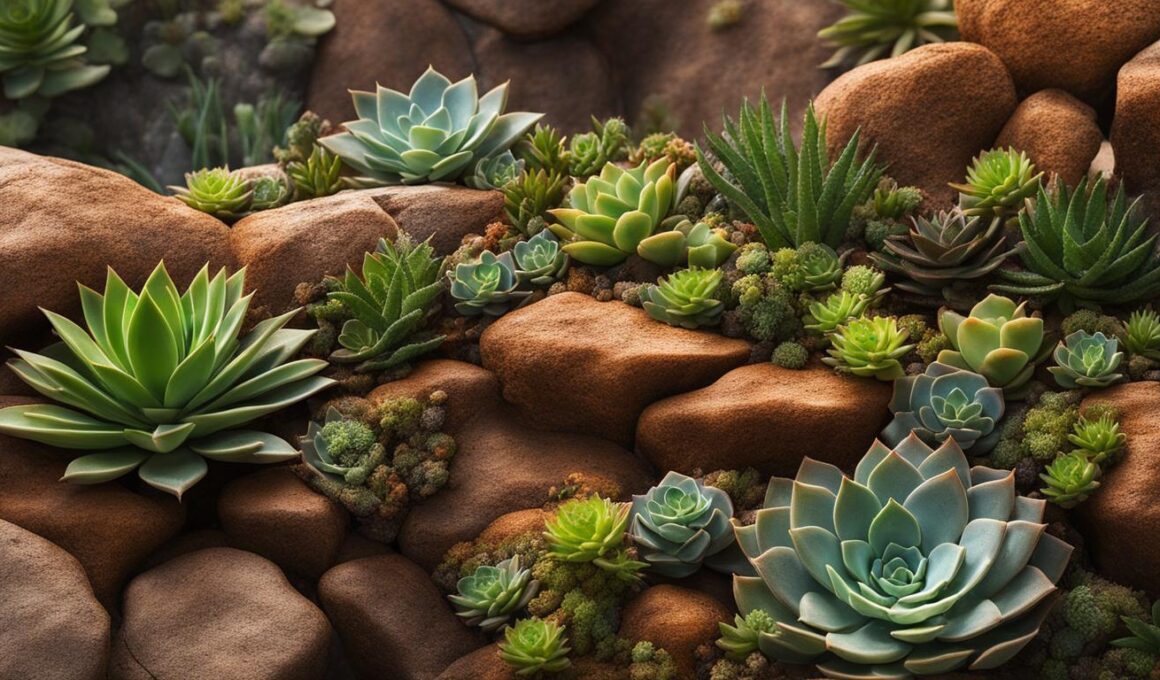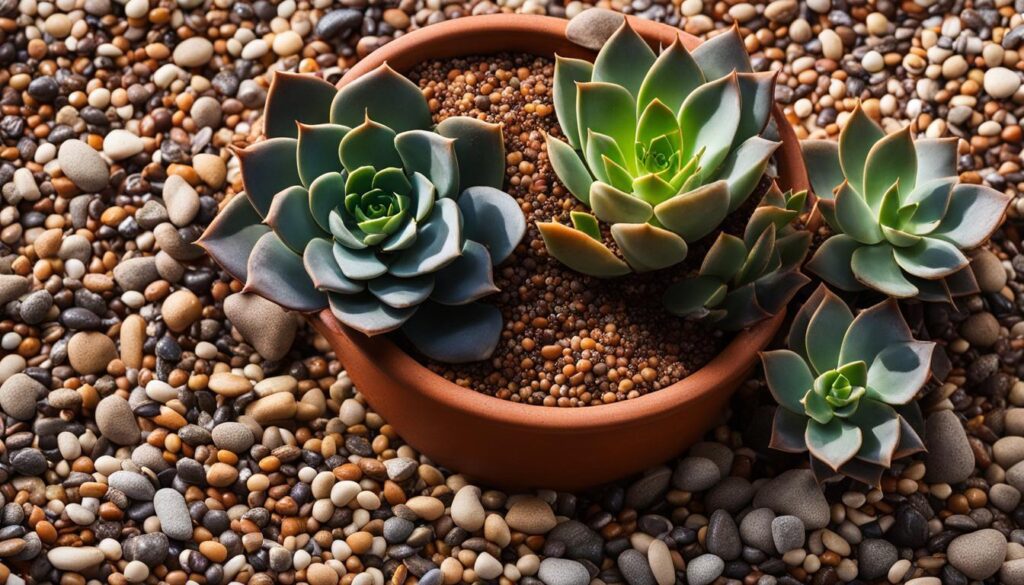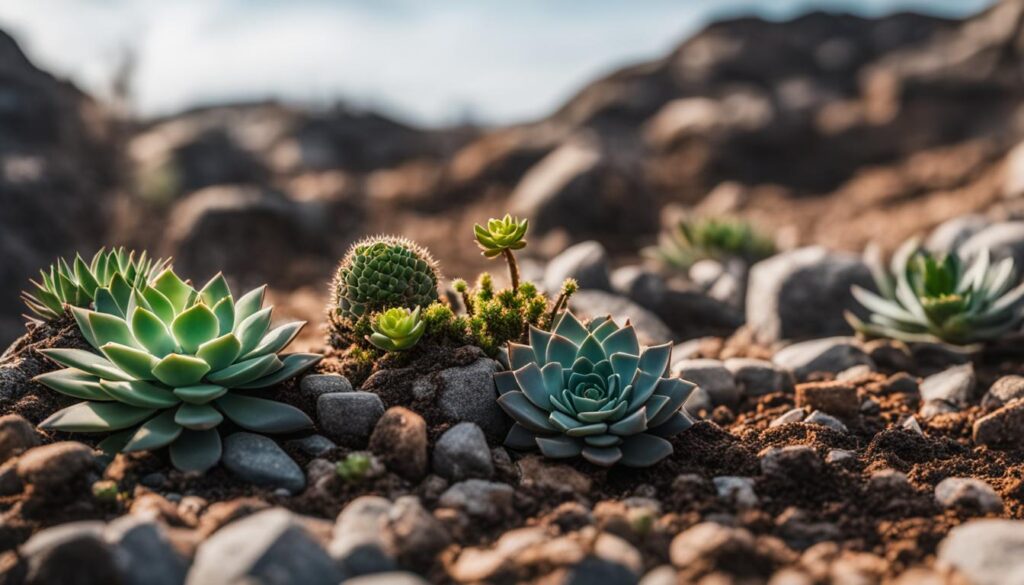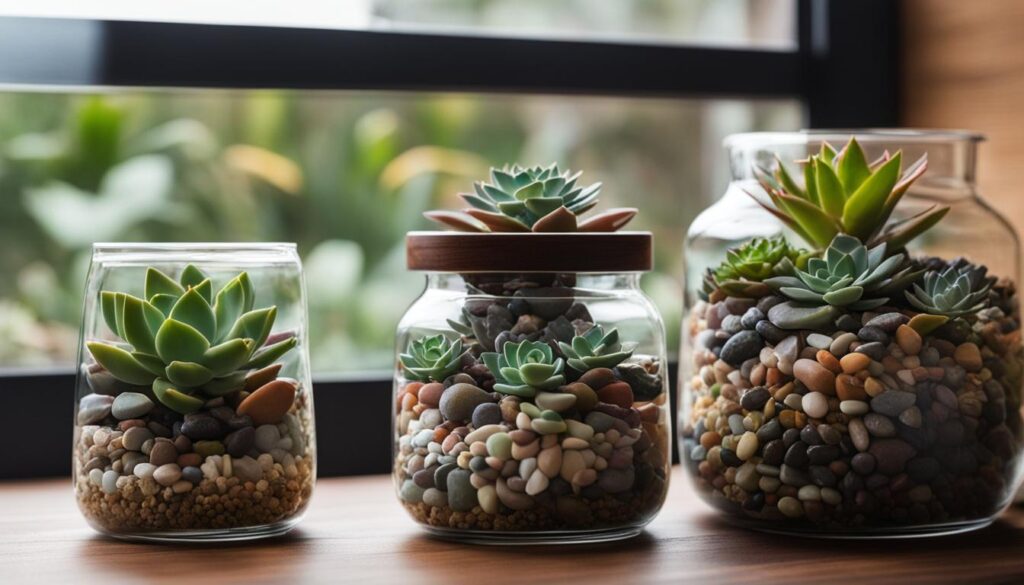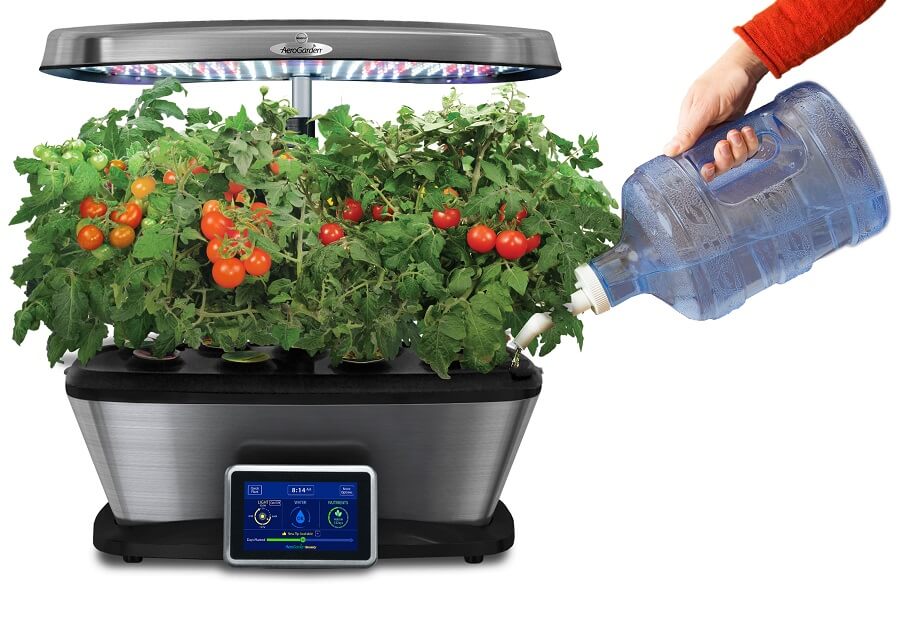Succulents are trendy and highly sought-after plants known for their low-maintenance nature and ability to thrive in well-draining soil. If you’ve ever wondered if you can grow succulents in rocks alone, the answer is no. While planting succulents in rocks for decorative purposes is possible, they cannot sustain long-term growth without the necessary nutrients.
When it comes to succulent care, providing the proper growing conditions is essential. Succulents need a well-draining soil that prevents root rot and allows them to thrive. Rocks, on their own, do not provide the ideal environment for succulent growth. They lack the necessary nutrients and tend to drain too quickly, leaving the roots dry.
Post Summary
- While you can plant succulents in rocks for decorative purposes, they cannot grow long-term without the right soil and nutrients.
- Well-draining soil is crucial for the health and growth of succulents, preventing root rot caused by excessive moisture.
- Rocks alone do not provide the necessary nutrients for succulent growth and can lead to root rot.
- You can create the illusion of succulents growing in rocks by hiding the soil with layers of rocks or using clay pebbles to provide water and nutrients.
- Consider planting succulents in glass jars or terrariums, but ensure proper drainage to prevent excess moisture accumulation.
The Importance of Well-Draining Soil for Succulents
Succulents are unique plants that have adapted to survive in harsh, arid environments by storing water in their leaves. To thrive and stay healthy, these plants require well-draining soil that allows excess water to flow through and prevents the roots from sitting in moisture. The importance of well-draining soil for succulents cannot be underestimated, as it plays a crucial role in preventing root rot and ensuring long-term growth.
Well-draining soil is essential for succulents because their leaves store water, making them susceptible to rot if the soil remains overly moist. Sandy or rocky soil with good drainage is ideal for succulents because it allows water to pass through quickly, preventing the roots from becoming waterlogged. Regular potting soil used for succulents is often amended with materials like river sand, bark, or rocks to increase drainage and create an optimal growing medium.
By using well-draining soil, you can mimic the natural habitat of succulents and create an environment that promotes healthy growth. This type of soil ensures that excess water is efficiently removed from the root zone, preventing issues like root rot and fungal diseases. Additionally, well-draining soil helps distribute water evenly to the roots, allowing the plants to access the moisture they need without becoming waterlogged.
| Benefits of Well-Draining Soil for Succulents |
|---|
| Prevents root rot |
| Allows excess water to flow through |
| Mimics the natural habitat |
| Distributes water evenly to the roots |
When planting or repotting succulents, it is crucial to choose a well-draining soil mixture that provides the right balance of nutrients, moisture retention, and drainage. This will help ensure the health and longevity of your succulents, allowing them to thrive in their unique and fascinating way.
Why Succulents Cannot Grow in Rocks Alone
Succulents are resilient plants that have adapted to survive in arid environments. While they can withstand harsh conditions, they still require certain conditions to thrive. Unfortunately, rocks alone do not provide the necessary environment for succulent growth. Here are the limitations of planting succulents in rocks:
- Lack of nutrients: Succulents may not be hungry plants, but they still need essential macronutrients and micronutrients to grow and stay healthy. Rocks do not contain these nutrients, leading to nutrient deficiencies and slow deterioration of the plant over time.
- Poor water retention: Rocks drain water very quickly, leaving the roots of succulents dry within a few hours. Succulents have adapted to store water in their leaves, but without a consistent water source, they will suffer and eventually die.
- Inadequate root support: Rocks may provide stability, but they cannot offer the necessary support for the roots of succulents. Without a suitable growing medium, the roots may struggle to anchor themselves and absorb water and nutrients effectively.
While succulents may appear to survive in rocks for a short period, it is not a sustainable long-term solution. To ensure the health and longevity of your succulents, it is important to provide them with the proper growing conditions and nutrient-rich soil.
Placing succulents in rocks alone is like expecting a fish to thrive in a desert. Despite their hardiness, succulents need more than just rocks to flourish. Without the right nutrients, water retention, and root support, succulents will struggle and eventually wither away. So, if you want to enjoy the beauty of succulents, be sure to provide them with the suitable environment they need to thrive.
The Importance of Proper Soil for Succulents
Soil plays a crucial role in the growth and health of succulents. The ideal soil for succulents is well-draining, allowing excess water to flow out easily. This helps prevent overwatering and root rot, which can be detrimental to succulent plants. To create the perfect soil mix for succulents, combine regular potting soil with sand, perlite, or pumice to increase drainage and improve aeration.
Remember, when it comes to planting succulents, choosing the right soil is just as important as selecting the right container and providing adequate sunlight. By creating the optimal growing conditions, you can enjoy thriving succulents that will bring beauty and tranquility to your space.
Creating the Illusion of Succulents Growing in Rocks
While succulents cannot grow in rocks alone, there are ways to make it appear as if they are growing in rocks. One method is to plant the succulent in regular potting mix and cover the soil with a thick layer of rocks. This creates the illusion that the plant is growing in rocks while still providing the necessary nutrients and moisture from the soil.
| Method | Description |
|---|---|
| Planting in potting mix with a layer of rocks on top | This method involves planting the succulents in regular potting mix and then adding a thick layer of rocks on top. It gives the impression that the succulents are growing directly in rocks while ensuring they still receive the necessary nutrients and moisture from the soil. |
| Using clay pebbles | Another way to create the illusion of succulents growing in rocks is by using clay pebbles. These pebbles resemble rocks but can absorb water and slowly release nutrients to the succulent. By placing the succulent on a layer of clay pebbles, it looks as if it’s growing in rocks while still receiving the necessary care. |
Another method to create the illusion of succulents growing in rocks is by using clay pebbles, which resemble rocks but can absorb water and slowly release nutrients to the succulent. Placing the succulent on a layer of clay pebbles gives the appearance of it growing in rocks while still providing the necessary care.
Overall, while succulents cannot grow in rocks alone, there are creative ways to plant them in such a way that gives the illusion of them growing in rocks. By using techniques like covering the soil with rocks or using clay pebbles, you can achieve a visually appealing succulent arrangement that adds a unique touch to your home or garden.
| Succulent Varieties for Glass Containers | Sunlight Requirements | Watering Needs | Growth Size |
|---|---|---|---|
| Echeveria | Full sunlight | Minimal watering | Small to medium |
| Haworthia | Indirect sunlight | Minimal watering | Small |
| Aloe | Full sunlight | Infrequent watering | Medium to large |
| Sedum | Partial sunlight | Infrequent watering | Small to medium |
Using Clay Pebbles as an Alternative to Rocks
When it comes to planting succulents, rocks are often used for decorative purposes. However, succulents cannot grow in rocks alone as they lack the necessary nutrients for long-term growth. That’s where clay pebbles come in as a great alternative. Clay pebbles, also known as LECA (lightweight expanded clay aggregate), offer several benefits for succulent planting.
One of the main advantages of using clay pebbles is their ability to absorb water and slowly release it to the succulent. This helps regulate moisture levels, preventing over-watering and root rot. Clay pebbles also provide a stable growing medium for succulents, allowing for healthy root development. Additionally, these pebbles are reusable and can be washed and used for other plants as well.
When it comes to planting succulents in clay pebbles, there are a few key steps to follow. Firstly, place a layer of clay pebbles at the bottom of the pot to improve drainage. Then, add a layer of succulent potting mix and gently place the succulent in the soil. Finally, fill the gaps between the plant and the pot with more clay pebbles.
Overall, using clay pebbles as an alternative to rocks is a practical and effective way to provide the necessary water and nutrients for succulent growth. Whether you’re creating a decorative arrangement or looking for a low-maintenance solution for your succulents, clay pebbles are a great choice.
Comparison between Rocks and Clay Pebbles for Succulent Planting
| Factors | Rocks | Clay Pebbles |
|---|---|---|
| Ability to absorb water | Low | High |
| Release of nutrients | None | Slow and gradual |
| Drainage | Moderate | Excellent |
| Reuse | No | Yes |
| Root development | Poor | Healthy |
Growing Succulents in Gravel
Growing succulents in gravel can present some challenges, as gravel alone cannot provide the necessary water and nutrients for sustained growth. However, gravel can still play a beneficial role in succulent cultivation by improving drainage and preventing root rot. By using the correct planting techniques and providing additional care, you can successfully grow succulents in gravel arrangements.
Challenges of Growing Succulents in Gravel
While gravel can help with drainage, it does not retain moisture or provide essential nutrients for succulent growth. The coarse texture and minimal organic matter in gravel make it difficult for the plants to access the water and nutrients they need. As a result, succulents grown solely in gravel may struggle to thrive and may show signs of dehydration or nutrient deficiencies.
Additionally, succulents planted in gravel arrangements require careful watering. The quick-draining nature of gravel means that water passes through rapidly, making it challenging to ensure consistent moisture levels. Succulents may need more frequent watering, and it’s crucial to monitor their hydration to prevent underwatering or overwatering.
| Challenges of Growing Succulents in Gravel |
|---|
| Gravel does not provide essential water and nutrients |
| Minimal organic matter in gravel |
| Difficulties in maintaining consistent moisture levels |
However, with the right techniques and care, you can overcome these challenges and create a thriving succulent garden in gravel.
Tips for Planting Succulents in Gravel Arrangements
If you’re looking to create a unique and visually appealing succulent arrangement, using gravel as a planting medium can be a great option. While succulents cannot grow in gravel alone, with the right techniques and care, you can successfully incorporate them into your gravel arrangements. Here are some tips to help you get started:
1. Provide the necessary nutrients
It’s important to remember that gravel does not provide the nutrients that succulents need to thrive. To ensure your succulents stay healthy and vibrant, you’ll need to supplement them with the necessary nutrients. One way to do this is by using a slow-release succulent fertilizer. Apply the fertilizer according to the instructions provided and be cautious not to over-fertilize, as this can be detrimental to the plants.
2. Top up the soil
Over time, the soil in your gravel arrangement may become depleted of nutrients. To keep your succulents well-fed, periodically top up the soil with a succulent-specific potting mix. This will provide the necessary organic matter and nutrients for the succulents to continue growing and thriving in the gravel medium.
3. Choose the right species
Not all succulent species are suitable for growing in gravel arrangements. Some are more adaptable to arid environments and can tolerate the lack of organic matter in the gravel. Before planting succulents in your gravel arrangement, research and select species that are known to thrive in drier conditions. This will increase the chances of success and ensure your plants remain healthy and happy.
Remember, while planting succulents in gravel can be an attractive and creative way to display these plants, it requires extra care and attention to provide the necessary nutrients. By following these tips, you’ll be well on your way to creating stunning gravel arrangements that showcase the beauty of succulents.
| Succulent Species | Watering Frequency | Sunlight Requirements |
|---|---|---|
| Echeveria | Once every 1-2 weeks | Full sun to partial shade |
| Sedum | Once every 2-3 weeks | Full sun |
| Aloe | Once every 2-3 weeks | Full sun |
| Haworthia | Once every 2-3 weeks | Partial shade to bright indirect light |
Conclusion
While planting succulents in rocks or gravel alone is not viable for long-term growth, there are creative ways to incorporate these materials into decorative arrangements. By hiding the soil with layers of rocks or using clay pebbles to provide water and nutrients, you can create the illusion of succulents growing in rocks or gravel.
However, it’s important to understand the limitations of these planting methods. Rocks do not offer the necessary nutrients for succulent growth, and gravel alone cannot provide sufficient water and nutrients. Succulents may survive for a short period in these materials, but without consistent care and the right soil, they will slowly deteriorate.
To ensure the long-term health of your succulents, it is recommended to eventually repot them using proper succulent potting mix. This will provide the necessary drainage and nutrients for their continued growth. Remember to choose the right species of succulent that can tolerate growing in rocks or gravel and consider using fertilizer to supplement the nutrient deficiency in these materials.
Can the Color Change in Succulents Affect Their Ability to Grow in Rocks?
Can the color change in succulents affect their ability to grow in rocks? That depends on why succulents change color. The color change in succulents is usually a response to environmental conditions like light or temperature. While it may not directly impact their ability to grow in rocks, it could be an indication of their overall health and adaptability. Ultimately, understanding the reasons behind succulent color change can provide valuable insights into their growth patterns and requirements.
FAQ
Can I plant succulents in rocks?
No, succulents cannot grow long-term in rocks alone. Rocks do not provide the necessary nutrients for succulent growth and can lead to root rot. However, there are ways to create the illusion of succulents growing in rocks by hiding the soil with layers of rocks or using clay pebbles to provide water and nutrients.
Why do succulents need well-draining soil?
Succulents require well-draining soil to prevent root rot. Their leaves store water, and if the soil retains too much moisture, the roots can become mushy and the plant can rot. Sandy or rocky soil that drains well is ideal for succulent growth.
Why can’t succulents grow in rocks alone?
Rocks do not provide the necessary nutrients for succulent growth. While succulents are not hungry plants, they still require essential macronutrients and micronutrients for healthy growth. Rocks also drain too quickly, leaving the roots dry within a few hours. Succulents may survive in rocks for several weeks or even months due to the water and nutrients stored in their leaves, but without consistent care and the right soil, they will slowly die.
How can I create the illusion of succulents growing in rocks?
One method is to plant the succulent in regular potting mix and cover the soil with a thick layer of rocks. This creates the illusion that the plant is growing in rocks while still providing the necessary nutrients and moisture from the soil. Another method is to use clay pebbles, which resemble rocks but can absorb water and slowly release nutrients to the succulent.
Can I plant succulents in glass jars or terrariums?
Yes, you can plant succulents in glass jars or terrariums. To prevent excess water from sitting around the roots, add a layer of coarse rocks at the bottom of the container. Then, place a layer of soil in the center, plant the succulent, and fill the gaps with rocks to hide the soil. It’s important to leave the container open to prevent humidity buildup and to place it in a sunny spot for optimal sunlight exposure.
What are clay pebbles and how can I use them for succulent planting?
Clay pebbles, also known as LECA (lightweight expanded clay aggregate), can be used as an alternative to rocks in succulent planting. These pebbles resemble rocks but can absorb water and slowly release nutrients to the succulent. They offer benefits such as moisture regulation and lower maintenance, making them suitable for gardeners who tend to over-water their succulents. Clay pebbles are reusable and can be washed and used for other plants as well.
Can succulents grow in gravel?
Succulents cannot grow in gravel alone as it does not provide the necessary water and nutrients. However, gravel can be used to improve drainage and prevent root rot. By placing potting pebbles at the bottom of the pot, succulents can thrive by allowing excess water to drain away. It is important to remember that succulents still need a growing medium to stay healthy and look good.
What are some tips for planting succulents in gravel arrangements?
Firstly, use fertilizer to provide the necessary nutrients that the gravel cannot provide. Additionally, top up the soil occasionally to ensure the succulent receives enough nutrients. It is also important to choose the right species of succulent that can tolerate growing in gravel. Lastly, plan to repot the succulents eventually, as they may outgrow the gravel arrangement and require a proper succulent potting mix.





